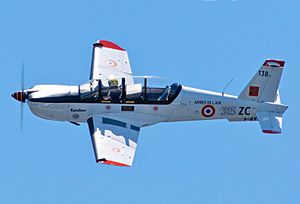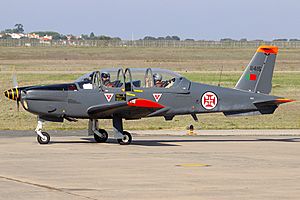Socata TB 30 Epsilon facts for kids
class="infobox " style="float: right; clear: right; width: 315px; border-spacing: 2px; text-align: left; font-size: 90%;" ! colspan="2" style="text-align: center; font-size: large; padding-bottom: 0.3em;" | TB 30 Epsilon |-
|- | colspan="2" style="text-align: center;" |  |- |colspan="2" style="border-bottom: 1px solid #aaa;text-align:center;" |Socata TB 30 Epsilon |-
|- |colspan="2" style="border-bottom: 1px solid #aaa;text-align:center;" |Socata TB 30 Epsilon |-
! Role | Light military trainer aircraft |-
! Manufacturer | SOCATA (Aérospatiale) |-
! First flight | 22 December 1979 |-
! Introduction | 1983 |-
! Status | Active service |- ! Primary users | French Air Force (historical)
Portuguese Air Force
Togolese Air Force
Senegalese Air Force |- ! Produced | 1979-1989 |-
|} The Socata TB 30 Epsilon is a special kind of airplane used to teach new pilots how to fly for the military. It's a light aircraft, meaning it's not huge or super heavy. It was made by a company called SOCATA, which was part of Aérospatiale back then. This plane has two seats, one behind the other, so an instructor can sit with the student. It's built mostly from metal. The very first one flew for the first time on December 22, 1979.
Contents
How the Epsilon Was Designed and Built
Why a New Trainer Plane Was Needed
In 1978, the French Air Force (also known as the Armée de l'Air) needed a new basic trainer plane. They wanted to replace some of their older planes, like the Fouga Magister, for the first steps of pilot training. The new plane needed to have two seats, one behind the other, and be powered by a 224 kilowatt (300 horsepower) piston engine. It also had to be able to fly for three hours without needing to refuel.
Choosing the Best Design
Two main designs were suggested. One came from SOCATA, a part of Aérospatiale, and was based on their TB 10 Tobago light aircraft. The other was from a company called GEPAL. In February 1979, the SOCATA design, called the TB 30B, was chosen.
First Flights and Improvements
The first two test planes flew on December 22, 1979. However, early tests showed that the Epsilon was a bit tricky to fly. So, the designers made some changes. They gave it a new, swept-back tail fin and a larger tail section. They also added special tips to the wings, making them a bit wider.
The first test plane flew again with these changes on October 31, 1980. This time, the flying problems were fixed!
What the Epsilon Looks Like and How it Works
The Epsilon is a cantilever monoplane, which means it has one main wing that sticks out from the body without extra supports. It's made entirely of metal. The plane is powered by a Lycoming O-540 flat-six piston engine. This engine turns a two-blade propeller at the front.
The Epsilon also has a nosewheel undercarriage that can be pulled up into the plane during flight. The pilot and instructor sit one behind the other under a clear plastic canopy that slides open. The cockpit is designed to help students easily switch to the Dassault/Dornier Alpha Jet, which is the next plane French students learn to fly after the Epsilon.
The Turboprop Version: TB 31 Oméga
One of the early Epsilon test planes was changed to try out a different kind of engine: a Turbomeca TP 319 Arrius turboprop engine. This new version flew on November 9, 1985.
Later, this test plane was turned into a special turboprop trainer called the TB 31 Oméga. It had a more powerful 360 kilowatt (483 horsepower) Arrius 1A2 engine and even had ejection seats for safety. It flew again on April 30, 1989. This version was offered for a competition in the United States to replace older trainer planes, but it wasn't chosen, so no more were built.
Epsilon in Action
Serving the French Air Force
The French Air Force ordered 30 Epsilons in 1981. Later, they ordered more, bringing the total to 150 planes. The first Epsilons were delivered in 1983, and the first training classes using the Epsilon began in September 1984.
Epsilon Around the World
Other countries also bought the Epsilon. Togo ordered three armed Epsilons in 1984, which were delivered in 1986. They later received a fourth one to replace a plane that had crashed. Portugal ordered 18 aircraft in 1987. These planes were put together in Portugal by a company called OGMA.
Different Types of Epsilon Planes
- TB 30 Epsilon: This is the main military trainer aircraft.
- TB 31 Oméga: This was a proposed version of the TB 30 Epsilon that used a turboprop engine. Only one of these was ever built.
Who Uses the Epsilon?
Current Users
- Portuguese Air Force
- Senegalese Air Force
- Togolese Air Force
Former Users
Quick Facts About the Epsilon
The Socata TB 30 Epsilon is a capable trainer aircraft. Here are some interesting facts about its performance:
- Crew: 2 (a pilot and an instructor)
- Length: About 7.59 meters (24 feet 11 inches)
- Wingspan: About 7.92 meters (26 feet)
- Maximum Takeoff Weight: Up to 1,250 kilograms (2,756 pounds)
- Engine: One Lycoming AEIO-540-L1B5D 6-cylinder piston engine, providing 300 horsepower.
- Top Speed: Can reach about 378 kilometers per hour (235 miles per hour).
- Cruise Speed: Flies comfortably at about 358 kilometers per hour (222 miles per hour).
- Range: Can fly up to 1,300 kilometers (808 miles) on one tank of fuel.
- Ceiling: Can fly as high as 7,010 meters (23,000 feet).
- Climb Rate: Can climb at about 9.4 meters per second (1,850 feet per minute).
- Armament (Export versions): Some versions sold to other countries could carry up to 480 kg (1,100 lbs) of weapons on four points under the wings.
See also
 In Spanish: Aérospatiale (Socata) Epsilon para niños
In Spanish: Aérospatiale (Socata) Epsilon para niños
- Aircraft related to this one
- Socata TB 10 Tobago
- Similar aircraft
- ENAER T-35 Pillán
- Lists related to this aircraft
- List of civil aircraft


